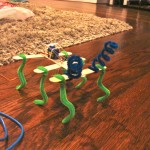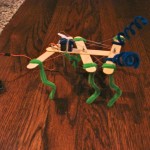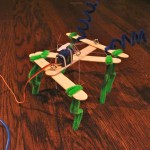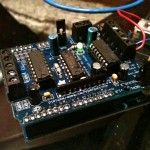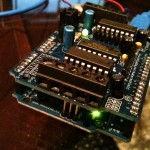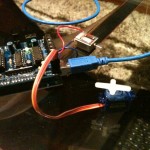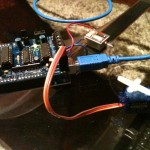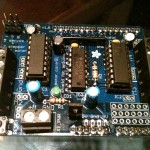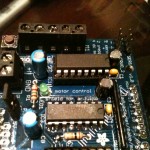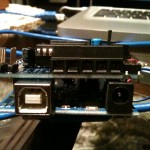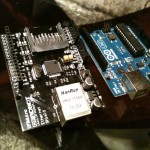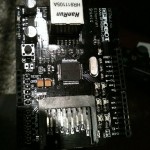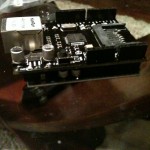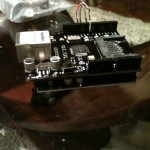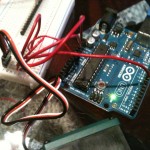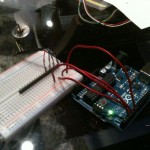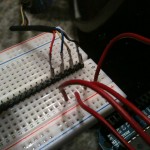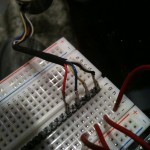I saw this “Popsicle Bug” robot on this website. I was very inspired by it and wanted to make one of my own. It reminded me of my old lego projects that I did in college. Except this was very light weight. The original maker left it very organic which is what I wanted to do and its fairly inexpensive to make. I used regular thread from my wife’s stitching box instead of a fish line. You can pretty much use any string/thread thats strong enough to handle the tension.
Tag Archives: arduino
Arduino: Adafruit Motor Shield
Finally had to give in and get a motorshield for the Arduino. I purchased it from RobotShop not knowing that it was a kit (i.e. you build it yourself). I should have read the title of the item a little better. It was fun to build the shield with these instructions PDF. It helped me build up some soldering skills. Fortunately, I bought some soldering flux paste from Radio Shack which helped me keep my work clean. The shield lets me power up to 4 DC motors, 2 servos or 2 stepper motors. You can use it to power bigger motors using an external power supply. The shield has 4 H-Bridges provided by L293D chipset.
I set it up with a RC car which has 2 motors for steering and forward/reverse movement.
All the instruction on how to build the motorshield and how to use it with the library are available on this ladyada.net website
Arduino: Ethershield
Just got a Arduino Ethernet Shield from ebay. It uses a Wiznet W51000 chip. Its pretty easy to assemble to the Arduino Uno board, you just line up the pins and snap it into place. I also used the Webserver example to test it. The webserver example display the value of the analog pins A0 to A5 on a webpage.
Arduino: Controlling a 3 wire Servo with Potentiometer
Used a 10k POT to control the 3 wire Vex servo. The two end pins of the POT went to 5V and ground. The middle connection of the POT was connected to the analog in 0 (A0). The servo was connected to the 5V (red), ground (black) and digital pin 9 (D9, white). Used the knob example from the Arduino.cc website to program the board. I was also able to print the Analog value of the POT by using the code from the AnalogReadSerial example.
This can be used for steering mechanism.
Arduino: Stepper Motor
Bought a mini stepper motor with 5 wires. Its a Symbol Mini Stepper Motor run on 5V. I tried to use the schematic from this website where someone made a driver to run the motor. For some reason I couldnt get the circuit to work. Most likely it was the transistor or the resistor value. Instead, I tried connecting the motor directly to the pin out 2, 3, 4 and 5. Using the attached sketch file, I was able to run the motor. This motor did full rotation in 20 steps (1step = 18 degrees). Still needs more testing for speed etc. The original .pde file is set to move the motor in random direction and random speed. If you change the .pde file to use constant speed/direction use the following
Speed: 1 – 50 (50 being the fastest)
Direction: 1 – 20 (20 being a complete rotation)
Arduino: Servo
Used a Vex 3 wire servo from VexRobotics. I used a small example code for Arduino called Sweep to see how far the servo can turn. I was happy to find out that it can do 180 degree instead of 100 degree.
(From Vex Robotics)
- Rotation:100 degrees
- Stall Torque:6.5 in-lbs
- Voltage:4.4 – 9.1 Volts (Motor life will be reduced operating outside this range)
- PWM Input:1ms – 2ms will give full reverse to full forward, 1.5ms is neutral
- Black Wire:Ground
- Orange Wire:Power
- White Wire:PWM signal
- Current Draw:20mA to 1.5 A per Servo

Arduino: Clap count
Started with a small project. I had a small audio relay that I purchased as a hobby project a few year back called Mini Vox & Relay. This kit lets you activate a relay when it hears a noise. I lost the microphone that it came with, but fortunately I found one in my box of “things” that worked. I was able to connect the relay to the 5V of the Arduino and the output to Pin 11. The modified the Blink code example and made it count 3 sounds/claps. After 3 counts an LED would turn on.
The problem I ran into was the relay stayed connected as long as the sound. While the relay was connected, the counter kept counting. I had to put a delay after the count so the relay had some time to disconnect to get around this problem. Another way to fix this issue would be to look for a low signal after a high to complete a full count. Â Personal note: Pull Up/Down resistor!
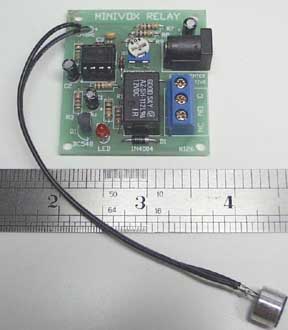
Arduino
It all started when I saw this post on Lifehacker.com to make a “Snail Mail Notifier for your Smartphone”. The post is about making a iphone sms push alert that would let you know when someone opens your mailbox (to deliver mail etc.). The video tutorial originated from Make magazine. It talks about this micro controller called Arduino.
“Arduino is an open-source electronics prototyping platform based on flexible, easy-to-use hardware and software. It’s intended for artists, designers, hobbyists, and anyone interested in creating interactive objects or environments.” via Arduino.cc

